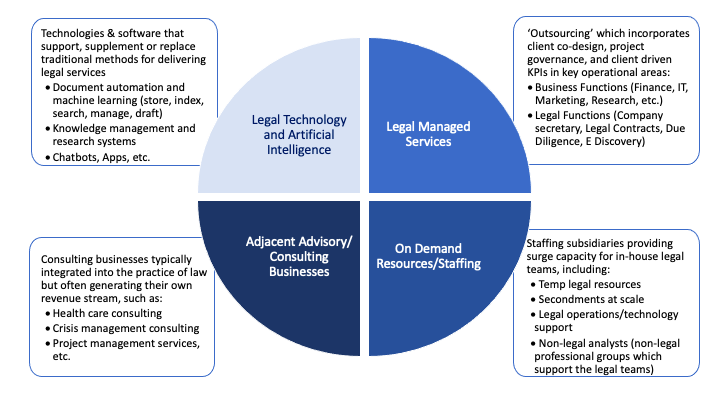The Rise of New Law
 While law firms have long experimented with adjacent businesses, recent industry changes have triggered a new level of investment in and focus on the formation of ‘New Law’ businesses. Given their recent emergence, the term New Law is not yet well defined and the application of New Law models continues to evolve with changes in technology and client demand. Despite this shifting marketplace, New Law offers opportunities for firms and merits more exploration by law firms seeking to differentiate their services, deliver enhanced value to their clients, and establish new sources of revenue.
While law firms have long experimented with adjacent businesses, recent industry changes have triggered a new level of investment in and focus on the formation of ‘New Law’ businesses. Given their recent emergence, the term New Law is not yet well defined and the application of New Law models continues to evolve with changes in technology and client demand. Despite this shifting marketplace, New Law offers opportunities for firms and merits more exploration by law firms seeking to differentiate their services, deliver enhanced value to their clients, and establish new sources of revenue.
Defining ‘New Law’
New Law is best defined as an evolution in the delivery of legal and legal adjacent services, with the end goal of providing superior value and efficiency for clients. The growing interest and investment in New Law is being driven by the changing nature of the buyers of legal services, which increasingly include a cross-section of stakeholders across the business-side, legal-side and legal operations of client organizations. These stakeholders and decision-makers face a variety of broader business changes and challenges which increase complexity and influence their views on how best to source legal and legal-adjacent services, including:
- Greater political, economic, environmental and social volatility
- Increased regulatory complexity
- Rapidly advancing and more sophisticated technology and big-data demands
- Need for greater specialization as the pace of knowledge change escalates
- Ongoing cost constraints
- Requirements for scale, responsiveness and agility
All of these trends contribute to growing complexity within the business environment. As a result, clients are increasingly seeking to solve multifaceted problems in both legal and legal-adjacent spaces.
In addition to changes in client needs and sourcing of legal and legal adjacent work, the competitive landscape has also changed dramatically. There is now upwards of a $10 billion market being ascribed to Law Companies, the legal sector businesses outside the traditional law firm model, formerly known as Alternative Legal Service Providers or ALSPs. This group ranges in scale and maturity from small start-ups to the Big 4, which have expanded into legal services as adjacent to their other professional services. Typically, Law Companies share a focus on utilizing data, process, and different resourcing models to meet complex and changing client value demands. Their emergence and rapid growth has provided clients with new choices and driven new expectations for what can be delivered by way of market insight, multifunctional service lines and greater service experience, efficacy and delivery.
This evolution of client needs and the competitive landscape has led to a proliferation of New Law services. In this environment, technical legal expertise and specialization are seen as table stakes, and by themselves, increasingly fail to sufficiently influence client stakeholders in the selection of law firm providers. In contrast to historic approaches to legal services delivery, New Law leverages data, technology, human capital and processes to deliver superior value to clients – above and beyond that of a simple price advantage.
Categories of New Law Business Models
Although New Law models are still forming and evolving as we write this Insight, we currently see four general categories of New Law services: Legal Technology and Artificial Intelligence, Legal Managed Services, On Demand Resources/Staffing, and Adjacent Advisory/Consulting Businesses Law.
A number of law firms have already started to harness opportunities in each of these four categories, and in some instances, law firms have pursued a New Law business model which overlaps two or more categories (e.g. consulting businesses which leverage technology/AI to customize solutions).
Within these four categories, a greater number of law firms are establishing New Law business models focused on adjacent advisory/consulting services or positioning themselves as Board-level advisors. Common law firm advisory or consulting businesses involve health care consulting, crisis management, climate change consulting, transaction planning, or project management services. Given the fit within the broader professional services category, this New Law model is one which law firms can easily relate to and more readily garner internal support. These services also require less infrastructure development than other New Law categories, and therefore can be more readily pursued and, in some instances, provide an earlier return on investment.
While adjacent advisory/consulting businesses may appear fairly straightforward on the surface, with relatively low barriers to entry, firms have experienced mixed results in actual performance. One of the elements which often differentiates the more successful law firm consulting subsidiaries from the less successful is where and how the law firm incorporates these additional consulting or advisory services into their broader service line – meaning how integrated these services are into the firm’s core legal services suite. Firms that operate these subsidiaries as a distinct, unintegrated business find that the return on investment is far less than firms that attach consulting to legal services offerings.
Pathways to New Law & Characteristics of Successful New Law Models
Law firms have pursued different paths to establishing a New Law business. Some firms have built these models from scratch, leveraging internal resources and organically growing the model through the gradual addition of capabilities and technology. Others have gone to market and acquired fully formed service teams and technology which essentially provide an off the shelf (or close to it) service or product offering. Still other firms have pursued a combination of build, buy, or partner approaches. Depending on which pathway a firm takes, firms must consider the different funding requirements – whether the approach requires a large up-front investment or more gradual funding over time – and assess the appropriate path based on the partnership’s appetite for investment and willingness to fund investments over time or up front.
Regardless of whether firms opt to build or buy (or pursue some combination thereof), success in New Law requires law firms to develop specific capabilities (beyond technical legal expertise) that provide the underpinnings of an effective New Law business model and assist in creating superior client value. These key capabilities include:
- Client Focused: A key characteristic of successful New Law models is service delivery that is designed from the perspective of the client. This requires first understanding the client’s definition of success, and then rethinking and reimagining core business processes and solutions through the lens of what the client is ultimately trying to accomplish – not a simple problem/solution model. This approach also informs how to most effectively position and brand the services with clients for maximum engagement.
- Multi-disciplinary, Business Consultancy Mindset: Firms that demonstrate the ability to frame legal issues within the client’s overall business, and recommend actionable solutions which help to close gaps and maximize opportunities are creating a New Law model which goes beyond legal and provides superior client value. To do this effectively, firms must also have the ability to package different services into a cohesive client driven solution – which includes traditional legal practitioners, advisory professionals (e.g. tax, economists, healthcare and other Sector experts) and business professionals (e.g. project management, change management, data analysts).
- Technology Enabled: A successful New Law model also positions itself on the front end of understanding and utilizing technology both in services delivery and within the firm’s own business model. For several categories of New Law, this also requires harnessing big-data, the massive amount of information at law firms’ and clients’ fingertips, in order to provide more efficient, accurate and predictive, services and solutions.
In addition to the above key capabilities, New Law business models typically also necessitate: 1) a separate P&L (to measure investment and ROI), 2) separate yet integrated leadership and governance structure (to ensure focused leadership attention, the requisite leadership skills and appropriate oversight), 3) alignment of incentives and compensation models, and 4) use of alternative fee arrangements (to more directly link value with services delivered).
Key Considerations in Launching a New Law Business
As more law firms contemplate the launch of a New Law model, there are a number of questions to consider before getting too far down the path. Three critical questions firm should ask early on in their evaluation process include:
1. How does New Law fit within your firm’s overall strategy?
Firms that have experienced success with New Law models have demonstrated a clear understanding of how the model enables the firm to better serve their clients, both today and in the future. It also requires understanding clients’ current and evolving legal and legal adjacent needs. They also require firms to define the link between the New Law offering and the firm’s core areas of expertise and market/value position. By ensuring that New Law fits within the firm’s overall strategy and helps to provide more value to the firm’s client base, the firm will avoid falling into the trap of launching a New Law model that distracts the firm from its strategy or dilutes its market position.
2. How should our firm evaluate a New Law business opportunity?
In evaluating a New Law business opportunity, law firms should conduct a thorough internal and external analysis of opportunities and challenges based on an assessment of the competition, technology requirements, client demand, and talent available. This requires a detailed analysis of competitors’ market entry strategies, their products and offerings, and structures. It also requires an evaluation of internal organizational structure and operating norms which may need to be adapted to develop a New Law business, as well as the internal appetite for investment and ability to execute effectively.
3. How should our firm optimally structure a New Law business?
Successful New Law models also ensure structure follows strategy – meaning that the practices, functions, teams, processes and technology are designed to achieve a firm’s strategy. While this may seem obvious, misaligned structures act as a significant inhibitor to success both in terms of client experience and internal engagement. Examples of structures law firms have pursued include forming a separate entity as a standalone or subsidiary of the firm, forming a business unit within the firm, or partnering with a Law Company.
____________________________________
Despite the fact that the legal industry first started exploring New Law models back in the 1990s, New Law is still in the early stages of maturity, and there will likely be more re-shaping of New Law services and business models in the months and years to come. In the interim, law firms seeking to respond to changing client expectations, provide enhanced client value, and build new sources of revenue, would benefit from broader exploration of New Law opportunities within their specific strategic context.

